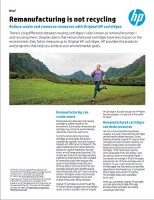The document says remanufacturing “is not recycling”, can “create waste [and] drain resources”, and says remanufactured cartridges “may not be the environmentally responsible choice they seem to be”.
The document appears to be aimed at HP dealers, and is titled Remanufacturing is not recycling, with topic headers throughout the piece including “remanufacturing can create waste”, “remanufactured cartridges can drain resources”, and “remanufacturing doesn’t provide an end-of-life solution”.
Stating that dealers can “reduce waste and conserve resources with original HP cartridges”, the OEM states that “there’s a big difference between reusing cartridges—also known as remanufacturing— and recycling them”, adding that “despite claims that remanufactured cartridges have less impact on the environment, they fail to measure up” to HP’s originals.
Elaborating on how remanufacturing “can create waste”, HP comments that remanufacturers “often claim that reusing cartridges is a better choice for the environment”, but adds that “in reality, remanufactured cartridges may not be the environmentally responsible choice they seem to be”, as “during the remanufacturing process, cartridges are pried apart and glued or clamped back together. Parts are reused or replaced with aftermarket components. The waste created during the remanufacturing process isn’t always responsibly recycled”.
HP mentions an InfoTrends study, which it says found 23 percent of toner and 35 percent of inkjet cartridges and parts collected by remanufacturers “were unusable for remanufacturing” as they “could not be profitably remanufactured”, and of these, 50 percent and 30 percent of toner and inkjet cartridges and parts thus “go to landfill because many remanufacturers don’t have a recycling process. Damaged, excess, and previously remanufactured cartridges may be sold multiple times before being discarded”.
Discussing how remanufactured cartridges “drain resources”, the OEM moves on to claim that “not only is the remanufacturing process wasteful, but using remanufactured cartridges can also lead to wasted resources”, citing its own tests with SpencerLab that apparently showed original HP LaserJet toner cartridges “provided consistent reliability and impressive page quality as compared with tested remanufactured and other non-HP cartridges”.
The tests also apparently showed that 35 percent of pages on average produced by remanufactured cartridges “were of limited or no use”. The OEM says that the remanufacturing process “produces cartridges that are often used only once before ending up in a landfill”, and that remanufacturing “doesn’t provide an end-of-life solution”, claiming that “you might think that remanufacturers reuse cartridges again and again, but often that’s not the case”
It cites another InfoTrends study that saw only 22 and 15 percent of toner and inkjet cartridges “remanufactured more than once”, as most remanufacturers surveyed “fail[ed] to collect their own products because they prefer to work with cartridges that have never been remanufactured before”. The OEM goes on to allege that “nearly 90 percent of the ink and toner cartridges sold by remanufacturers surveyed will ultimately be thrown away”.
The OEM has previously attempted to discourage remanufacturing in Australia in August this year, as well as calling it a “myth” in June 2013, and even discouraged refilling in India in February 2013. Additionally, its executives were quoted openly claiming that “remanufactured cartridges don’t work” in April 2012, with EMEA spokesman Leobert Faessler interviewed in September this year and quoted as saying that “the CO2 footprint of remanufactured cartridges was worse on average by 11 percent as for HP cartridges”.

